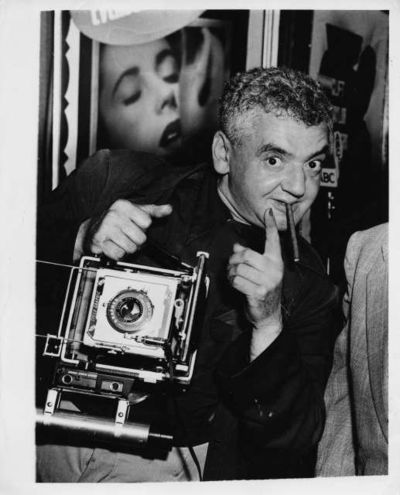
Weegee, a.k.a. photojournalist Arthur Fellig, derived his moniker from the phonic adaptation of the Ouija board, because of his customary arrivals at crime scenes minutes before the authorities. That was in his heyday in New York City during the 1930s and '40s, when he made a name for himself with his intrepid film noir-esque black-and-white photos of five-alarm fires, horrific accidents and the blood-spattered corpses of murdered mobsters.
In 1947, Weegee relocated to Los Angeles to take on the equally formidable Hollywood scene.
In conjunction with the Getty-sponsored Pacific Standard Time exploration of postwar L.A. art, the Museum of Contemporary Art is presenting "Naked Hollywood: Weegee in Los Angeles," billed as the first exhibit here devoted to work he produced in Southern California, including photos from his 1953 book "Naked Hollywood."
On view are his photos of striptease artists, costume shops, billboards and distorted images of movies stars such as Marilyn Monroe. Nearly 200 images, some never before seen, are drawn from the International Center of Photography, the Matthew Marks Gallery in New York and private collections.
Soon after his arrival, Weegee quickly realized what a strange culture Hollywood was and set about developing a trick elastic lens in response. It would stretch and twist an otherwise glamorous photograph into something grotesque, revealing the ugly side of celebrity.
"He was deeply critical and cutting in his attitude toward stardom," said Richard Meyer, curator of the MOCA exhibition and an associate professor of art history and fine arts at USC. "Fame itself is a type of distortion. It's created through manipulation of images."
Weegee wasn't considered a paparazzi in its current 24-hour stalking form, but he did capture stars in unflattering moments and unusual angles. One example is a 1951 photo of a voluptuous Elizabeth Taylor consuming her meal at an awards dinner. "Distorting the image of a star was his way of bringing them down a peg for their excesses," noted Meyer.
Weegee was also fascinated by the phenomenon of fandom, snapping countless photos of onlookers waiting to see stars at movie premieres. He'd zoom in on their awestruck and often devastated faces when they didn't get an autograph after waiting all night.
Despite his disdain for the culture of celebrity, Weegee experimented with filmmaking and often injected himself into the business as an actor, consultant and set photographer (for example, on Stanley Kubrick's "Dr. Strangelove or: How I Learned to Stop Worrying and Love the Bomb"). "His aspirations of becoming a rich and famous star were never realized, so he moved back to "civilization," what he called New York City, in early 1952, said Meyer. He was the inspiration for Joe Pesci's character in "The Public Eye."
The self-taught photographer was born Usher Fellig in 1899 in what is now Ukraine and died in 1968.
The self-taught photographer was born Usher Fellig in 1899 in what is now Ukraine and died in 1968.